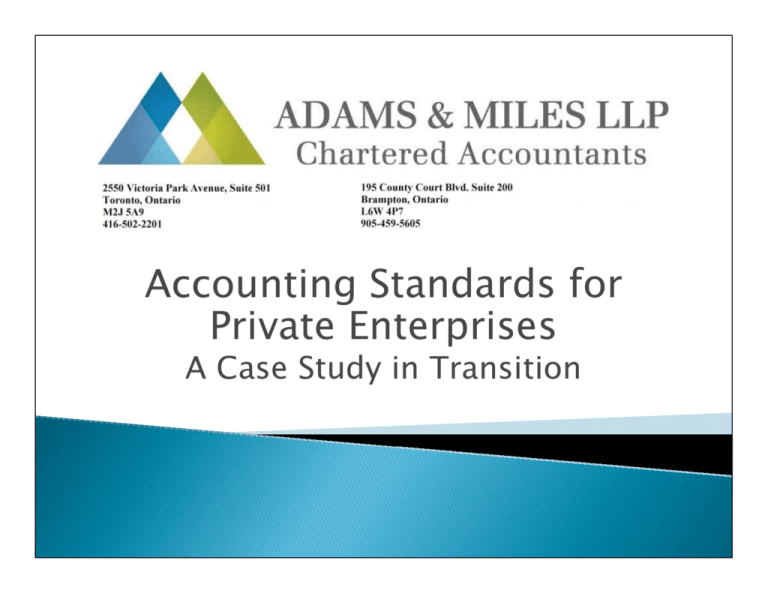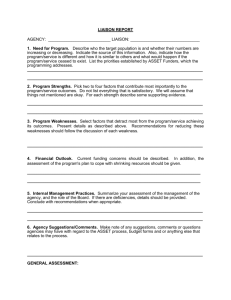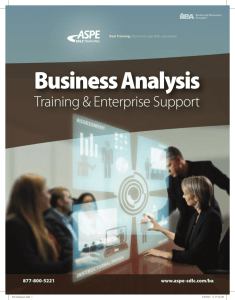Accounting Standards for Private Enterprises
advertisement

Accounting Standards for Private Enterprises A Case Study in Transition Although the presentation and related materials have been carefully prepared, neither the presentation authors, firm, nor any persons involved in the preparation and/or instruction of the materials accepts any legal responsibility for its contents or for any consequences arising from its use. ` This case study will review a practical application of the new accounting standards for private enterprises (ASPE) and will cover the following changes: Fair value Asset retirement obligations (ARO) Election for Property, Plant & Equipment Intangibles Government payables Income taxes Opening balance sheet Retained earnings and cash flow reconciliations for application of new standards ` ` ` Adoption –enterprises must adopt either ASPE or IFRS for fiscal years beginning on or after January 1, 2011. However early adoption is permitted. Handbook – now located in Part II Retrospective - is applying a new accounting policy to transactions, other events and conditions as if that policy had always been applied. ` ` Date of transition – beginning of the earliest period for which an entity presents full comparative information under ASPE, for example if you have a December 31 year end and the entity adopts ASPE for the 2011 fiscal year, the date of transition would be January 1, 2010. Effective date – is the first day of the fiscal year for which ASPE will be applied. For our example above, this date would be January 1, 2011. = ` ` ` Keep in mind that for many entities, this date has already passed. A one-time election exists to revalue property, plant and equipment to fair value on this date. Sources of fair value may include: ◦ Property tax assessments ◦ Appraisals ◦ Market values for similar assets ` Prepare the opening balance sheet ◦ Entities must show an opening balance sheet that is prepared in accordance with ASPE ◦ This includes a reconciliation of retained earnings and cash flows Castle Manufacturing Co. Ltd. (Castle Co.) ` ` ` ` Large, privately owned company located in the GTA that manufactures HVAC systems. The entity has a foreign subsidiary located in Mexico. Company currently uses differential reporting for income taxes, investment in subsidiary and financial instruments. Castle Co. has a December 31 year end, and it is now January 2012 and the controller is now preparing the December 31, 2011 financial statements and working papers. Please take some time now to review the financial statements prepared under existing GAAP. ` ` ` Fair value – the consideration that would be agreed upon in an arm’s length transaction between knowledgeable and willing parties. Investments in equity instruments quoted in an active market are subsequently measured at fair value. Investments not quoted in an active market are subsequently measured at cost less impairment. ` ` ` Book value is $100,000, which is cost of the original investments. Marketable securities include 1,785 common shares in Tim Hortons Inc. and a $50,000 GIC at Scotiabank purchased in July 2009. Market value at relevant dates: Transitional date (January 1/10)= $34.50 per share December 31/10 = $35.00 per share December 31/11 = $39.40 per share ` ` ` An ARO is a legal obligation (by law, statute or contract) to clean up your own mess at some future date! An ARO cost is an amount that is capitalized and increase the carrying amount of the asset when an obligation is recognized. Measurement obligation has now changed from a third-party estimate to Management’s best estimate. ` ` ` Measurement – upon initial recognition the carrying amount of the asset should increase by the same amount as the liability. Subsequently this amount is expensed using a systematic, rational method, typically over the remaining life of the asset. Initial recognition should be discounted using a current market risk-free rate of interest. Now because we are using the discounted cash flow, we will also record an increase in the obligation per year to adjust for the time value of money. An elective exemption is available to record ARO as of the transition date. ` Company maintains a container of coolant on the factory premise. If the Company were to vacate premise they would be required to remove the container as well as remove flooring within a 3 metre radius of the container. They would also have to remove and replace a minimum of 6 feet of soil under the container. The Company has been at their current location for over 30 years and has never considered moving thus has never set-up an obligation on the B/S. ` ¾ Management best estimate of costs: Removing container – $15,000 Removing and replacing flooring $13,000 Removing and replacing soil - $12,750 Under ASPE an obligation would be set-up on the B/S equal to Management’s best estimate - $40,750, discounted at 5% over 10 years would be $25,000. ` ` ` ` ` This is a one time election. The election must be done at the transition date. In the case study this would be January 1, 2010. This election can be done on an item by item basis. The fair value becomes the new cost of the PPE and future amortization calculations will need to use this new cost . Determining the FV will likely cost enterprises. ` ` The company premises are located on 12 acres of land that were purchased in the 1980s for $673,100. Originally the land was in a remote location between two farming communities, and was zoned commercial/industrial due to poor soil conditions. Now the surrounding towns have been built up and the land is now located in prime industrial space. Most recent property tax assessment has valued the land at $855,100. Brief detour ` Every second year the Company sends 6 to 8 sales reps to the annual Home Renovation trade show held in April each year as it sometimes receives new contracts from attendance at the show. But typically it is just to check up on the competition. The Company pays in November to take advantage of early bird discounts. Registration fees are 80% refundable 90 days before the show, but are otherwise nonrefundable. Total cost is $20,000 and every year the Company has recorded this as a prepaid expense. The Company has not decided which of its sales reps will be attending the show. ` An asset meets the identifiability criterion in the definition of an intangible asset when it: (a) is separable (i.e., is capable of being separated or divided from the entity and sold, transferred, licensed, rented or exchanged, either individually or together with a related contract, asset or liability); or (b) arises from contractual or other legal rights, regardless of whether those rights are transferable or separable from the entity or from other rights and obligations. ` An intangible asset shall be recognized if, and only if: (a) it is probable that the expected future economic benefits that are attributable to the asset will flow to the entity; and (b) the cost of the asset can be measured reliably. ` Is it separable? Could you sell it or transfer it to another Company/individual? Refundable at year-end, but not as of January 15. However the terms imply they are transferable. ` Does the Company have a contractual right? Yes ` Can it be measured? ¾ Is there a future economic benefit? Yes the Company has an invoice for $20,000. Arguably NO as they do not have a history of obtaining new contracts from the show and its primary purpose seems to be “SPYING”. ` ` ` ` New ASPE standards do not provide a section on “prepaids”, and the pure matching principle is no longer a viable reason for recording an asset. For any deposit or “prepaid” now, the default should be to expense, unless criteria exists to satisfy the definition of an asset. In our case study the trade show deposit should likely be expensed. Consider – if “prepaids” no longer exist, what should these assets be called on the B/S? ` ` ASPE now requires the separate disclosure of amounts that are payable and have been collected in a trust arrangement on behalf of the government. These would typically include GST/HST and source deductions. This disclosure can be a separate line on the B/S or a note disclosure. ` ` Taxes payable method OR future taxes method can be used Disclosure changes are minimal and a consistent with current disclosures under existing GAAP. ` ` Common presentation appears to be a third column on the current year’s balance sheet Remember, this opening balance sheet will include: Fair value presentation of the investments ARO increase of asset and corresponding liability (discounted) and accretion Election to increase the fair value of the land. ` Retained earning reconciliation at transition date is a note disclosure that outlines all the changes with respect to retrospective application of the new ASPE standards.








